
| On the previous pages, we have examined closely the pointillé tool imprints found on the decorative bookbindings that were produced in the workshops of Antoine Michel Padeloup during the first part of the eighteenth century. These imprints and their stylistic arrangements imitate closely the pointillé work of the previous century. In 1972 Raphaël Esmerian proposed that some of the Padeloup tools derived directly from Rocolet's workshop, (see page 73 of 2eme Partie: Reliures de quelques ateliers du XVII Siècle & Livres en divers genres du XVIIe et XVIIIe Siècles, from the 6 volume, 1972-74 publication entitled Bibliothèque Raphaël Esmerian. |

| This assumption was based partly on the fact that two of the Padeloup bindings in his collection closely resembled a 1642 Rocolet binding. G.D. Hobson had also previously made the same observation in his 1935 publication entitled Les Reliures à la fanfare, (p. 66). Thus we find that Esmerian has titled his chapter on Rocolet as: ATELIER PIERRE ROCOLET - ANTOINE PADELOUP 1638-1662 (p. 47). Below I have copied and pasted the important text from page 47 and page 48, where we also find a picture of the critically important 1642 Rocolet binding (No. 32). |
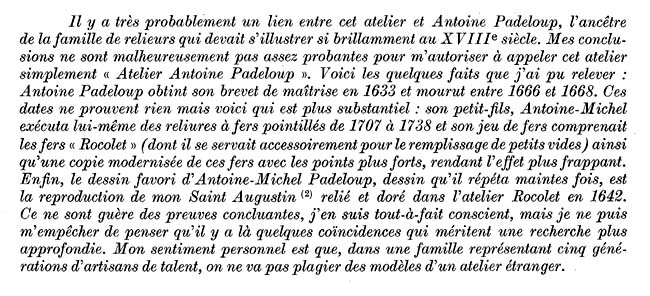
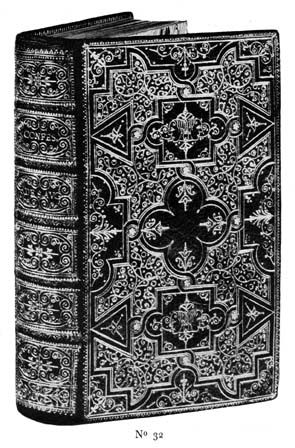
| I should remind the reader that Esmerian, in this same work (p. 47), claimed that Rocolet had acquired, in 1638, the tools of the Maitre Doreur. |
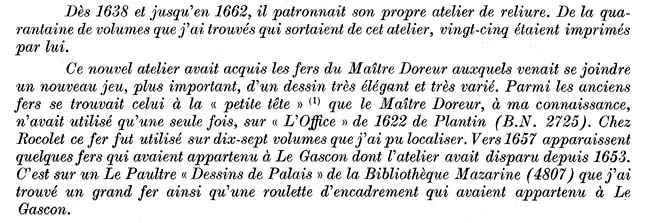
|
These facts are vitally important for anyone who is researching the bookbindings of the 17th and 18th centuries. If you discover a gold tooled binding that has been decorated with the tools of the Maitre Doreur, it may not necessarily mean that the work is that of the Maitre himself. Further to this we are asked to imagine that these tools passed from the hands of Rocolet all the way to the 18th century work of Padeloup. This is quite a revelation. In previous pages we have already made a thorough comparative study of the Maitre Doreurs tools and tackled this question of Rocolet's later possession of these tools. I am confident that on this point Esmerian is absolutely correct, and thus we see in the binding above, the continued presence of these tools. The question is whether or not some of them later passed into the hands of Padeloup le jeune. Sadly I must report, that after an intensive and exhaustive comparative analysis of the tool imprints found in a comprehensive sample of Padeloup's pointillé bindings, I have not found a single shred of evidence that could support such a theory. You will note that Esmerian is careful to say that the Rocolet tools to which he is referring were used by Padeloup to fill small spaces. This rules out any of the larger tools. Further to this Esmerian has provided comparative diagrams of the larger tools, showing that the Padeloup tools were similar but not identical. |
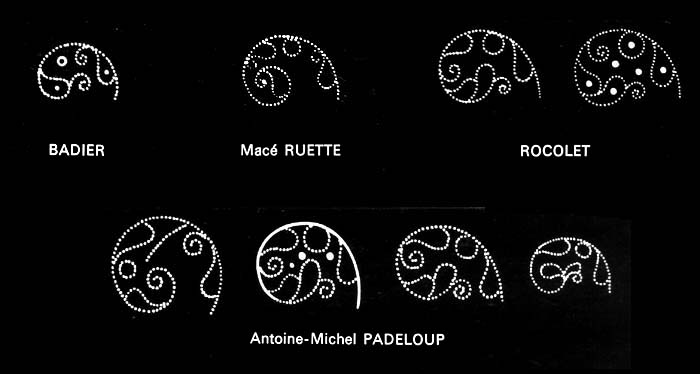
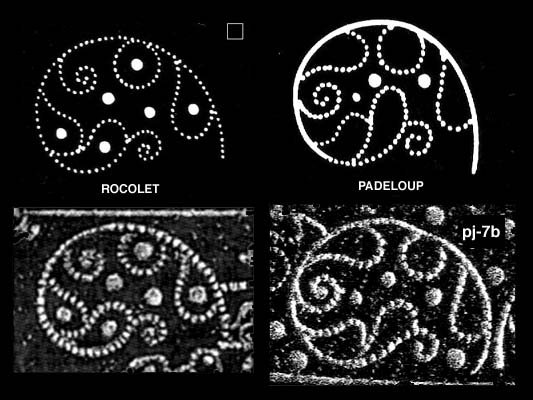
| Let us proceed now to look at all the likely Padeloup imprints that Esmerian may have considered to have derived from Rocolet tools, the first and most obvious candidates are pj-11a and 11b. |
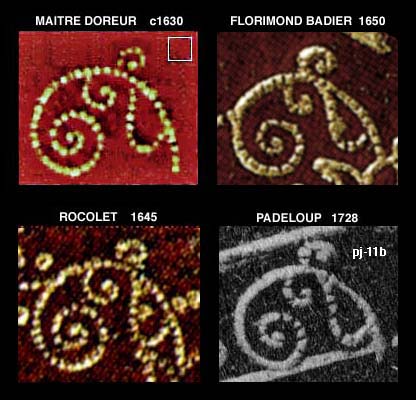
| In Comparative Diagram 2, I present a selection of actual imprint specimens, from these you can observe that the original Maitre Doreur tool is later found in the work of Rocolet, and that this tool was closely copied by Badier. More important however is the fact that the Padeloup imprint is not the same as the Rocolet/Maitre Doreur specimens and more closely resembles the Badier example, in fact this may be the same tool! |
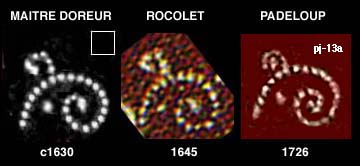
| The pj-13a and b imprints are possibly those which Esmerian associated with Rocolet's work, certainly they are a close call. In Comparative Diagram 3, I have reproduced these tiny imprints much enlarged. It is only when you see these imprints together, enlarged, on the same page that you can see, firstly that the Maitre Doreur and Rocolet imprints are the same and secondly that the Padeloup imprint is slightly different. Most obvious is the additional recurve of the inner spiral ending. |
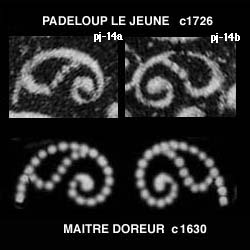
| In Comparative Diagram 4, I compare the Padeloup pj-14a and b imprints with my Maitre Doreur bead model of a similar tool, these very small imprints are a fraction smaller than pj-13a and b. They occur in the later Padeloup reproductions and are never very sharp, in fact I had to search quite a while to find one that showed any evidence of pointille segmentation. I had previously studied these tools very carefully in attempting to show differences in the Maitre Doreur, Mace Ruette examples. However, lacking any really high quality, high resolution samples of either, I resorted to reconstructing a bead model based on various extracted samples. I am quite confident in the resulting model which, when compared with the Padeloup example, again shows disturbing differences. The lack of good high resolution imagery in this case however, limits the scope and accuracy of our comparative analysis. Certainly these imprints are identical in size and approximate form. However in all seriousness, if Padeloup inherited the Rocolet tools, one would expect at least a few to be a bit more evident. |
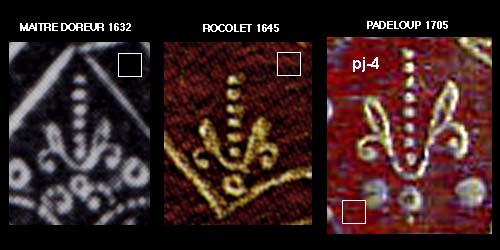
|
In Comparative Diagram 5, I have again shown a Maitre Doreur imprint as well as an identical Rocolet imprint, which derives from the same Maitre Doreur tool. Padeloup's tool emulates this model but is again slightly different and significantly larger. In conclusion then, I have not found any evidence to confirm the speculations of Raphaël Esmerian concerning the possible transmission of Rocolet's decorative pointillé tools into the hands of Padeloup le jeune. However I do not wish the reader to think that I have reported this as any sort of criticism of Esmerian's work. Quite to the contrary, I have the greatest respect for his extensive comparative research which serves as indispensable source of information to all those who care to follow in the fascinating study of decorative bookbinding in 17th century France. |
| Virtual Bookings, created by L. A. Miller | return to the Home page of VIRTUAL BOOKBINDINGS |